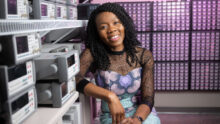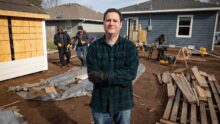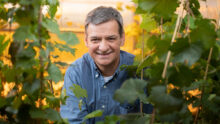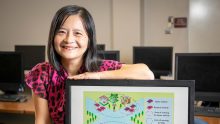Many mathematical processes depend upon this ability to sort information or attributes, and it’s a big part of machine learning, too, according to Dr. Tayo Obafemi-Ajayi. “The great thing about machine learning is it allows us this discovery of knowledge but also prediction,” Obafemi-Ajayi said. She is an associate professor of electrical engineering in Missouri State … [Read more...] about Pattern recognition enhances biomedical research
“This is one of the reasons you become a geologist if you grew up in the 1980s,” Dr. Matthew McKay said as he displays a video of him standing atop Mt. St. Helens. McKay, associate professor of geology at Missouri State University, mixes old school techniques of mapping and “disappearing into the woods” with the latest technology. It’s a passion, but there’s also important … [Read more...] about Connecting the rocks to tell the Earth’s story
It may erupt suddenly and violently terrorizing the town nearby, setting forth panic and destruction. It might slowly ooze. And another volcano might lay dormant for several more years – centuries even. It’s nearly impossible to predict. That is one of the goals of Dr. Gary Michelfelder’s research. For the last 15 years, Michelfelder, associate professor of … [Read more...] about A big one: Forecasting future volcanic eruptions
However, this animal struggles to survive through harsh winters. Tracking the population size and location of this mouse can serve as a “bellwether for climate change,” said Dr. Sean Maher, associate biology professor at Missouri State University. “My graduate advisor shared his research on the animal, and got me hooked on small mammals,” Maher said. Maher studies … [Read more...] about Mice population models much bigger picture
Dr. Ron Malega, associate professor of geography at Missouri State University, found this to be the case when growing up in metropolitan Detroit. His time spent working as a police officer reinforced the perspective. “Much of my interest in people and places stems from trying to understand this,” Malega said. “I’ve always questioned how could your race or ethnicity make … [Read more...] about Mapping the geography of opportunities
The associate professor of biology at Missouri State University makes his research and teaching understandable by comparing scientific processes to items you probably have lying around your house. A garden hose. Bottles of perfume. A paper towel roll. It’s all in the name of working toward a solution that could save people who are born with congenital heart and vascular … [Read more...] about Go with the flow
Sakidja is a professor in the department of physics, astronomy and materials science at Missouri State University, the nation’s only such combined department. Computational materials science uses modeling, simulation, theory and informatics to better understand materials. Sakidja’s research is varied, but his ultimate goal is the same. “Our overall research goal … [Read more...] about Celebrating collaborative research
This question fuels the research of Dr. Razib Iqbal, associate professor of computer science at Missouri State University. Much of Iqbal's research revolves around multimedia and the Internet of Things, or IoT. What is IoT? It could be anything connected to the internet — from a smart meter and appliances to smart smoke detectors and wearables. These things are capable of … [Read more...] about Humans as sensors: Making technology more intuitive
But as the availability of cultivable land diminishes and as climates change, our ability to grow enough food is becoming limited, too. This is the root of Dr. Laszlo Kovacs’ research. He’s a geneticist interested in the agricultural industry. “For most of history, we didn’t have to worry about food,” said Kovacs, biology professor at Missouri State University. “Now, with … [Read more...] about Root of the problem
Qiu, associate dean of the College of Natural and Applied Sciences and a geospatial sciences faculty member, asked a logical question: Why don’t people spread out more evenly? She imagined streets with less congestion. It felt like the perfect solution. But it’s never quite that simple, she learned. You have to consider infrastructure, landscape, natural resources and … [Read more...] about Connections: Data and real life
It’s not as simple as falling asleep and waking up in six months. Bats go into torpor, which is a physiological state, unlike sleeping, where almost everything is shut down. Bats live off their body fat during that time. Dr. Tom Tomasi, professor of biology, studies hibernating animals in torpor, especially bats. Some species of bats develop white nose syndrome. It sounds … [Read more...] about A tale of two bats: One lives, one dies
"When a house falls into a sinkhole, neighbors clamor for information. They ask if their house is next," said Dr. Doug Gouzie, geology professor at Missouri State University. "It's unimaginable and devastating, but I think they might not really want the answer to that question." Gouzie studies land formations, like sinkholes, and how water forms them. "Your house being … [Read more...] about Sinking suspicions: Predicting future disasters
Dr. Robert Pavlowsky has worked on nearly 100 projects related to water quality in the Ozarks region of southern Missouri and northern Arkansas. He is the director of the Ozarks Environmental and Water Resources Institute, also known as OEWRI, and a distinguished professor of geography. “I’m a geographer. We view the world at different levels.” The institute supports efforts … [Read more...] about Securing natural resources for the Ozarks
Our lives are full of connections. You see someone you know in the grocery store two aisles over. What's the quickest way to get to them? Your parents live 2,000 miles away. There are no direct flights. Which flight has fewer layovers? Connections are rarely as easy as point A to point B. There are stops along the way, twists, turns and sometimes you may even get … [Read more...] about Looking for connections
Although traditional communication systems may falter, data can still transfer from phone to phone until it reaches an area with service. This is called a wireless ad-hoc network – one of Dr. Hui "Anita" Liu’s research interests. When there is no central server, how can we implement a network functionality? According to Liu, devices must cooperate to form this network. Each … [Read more...] about Getting your message across when systems fail















